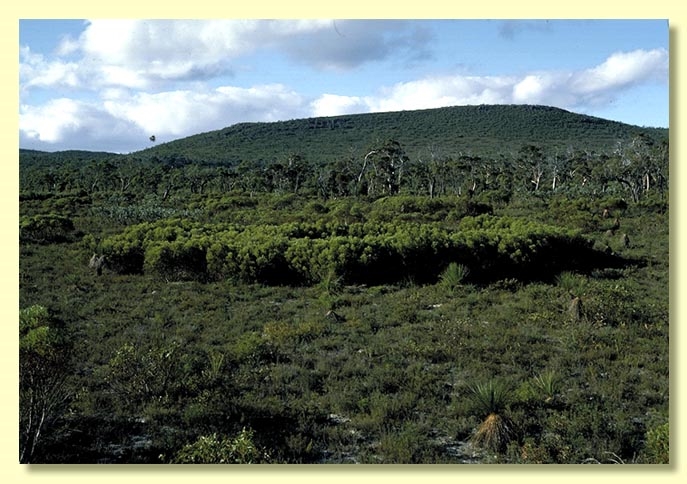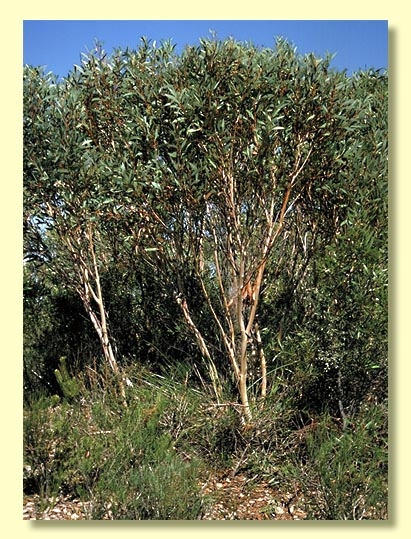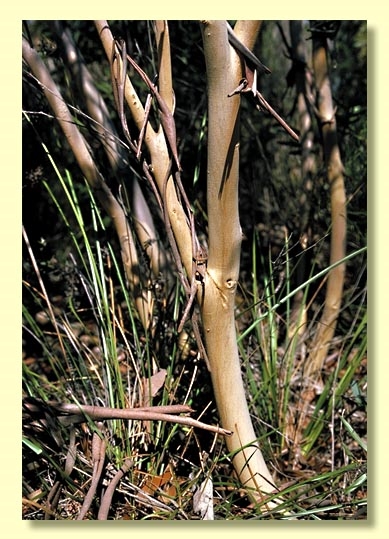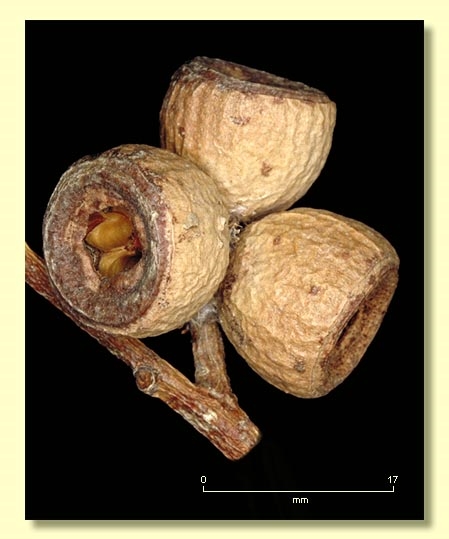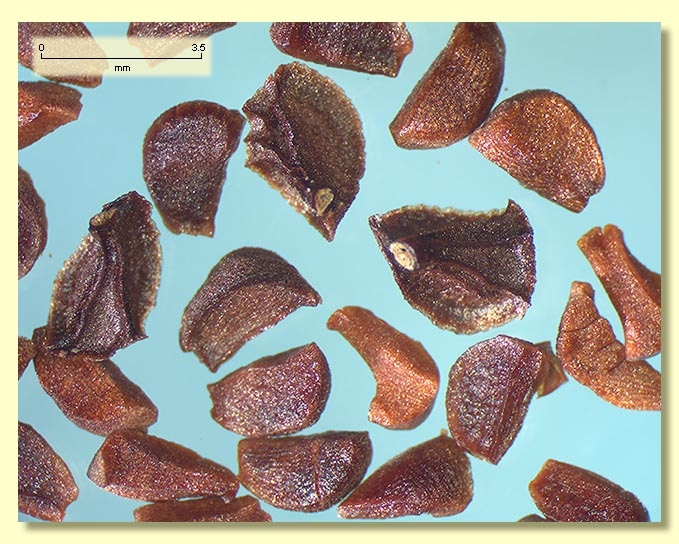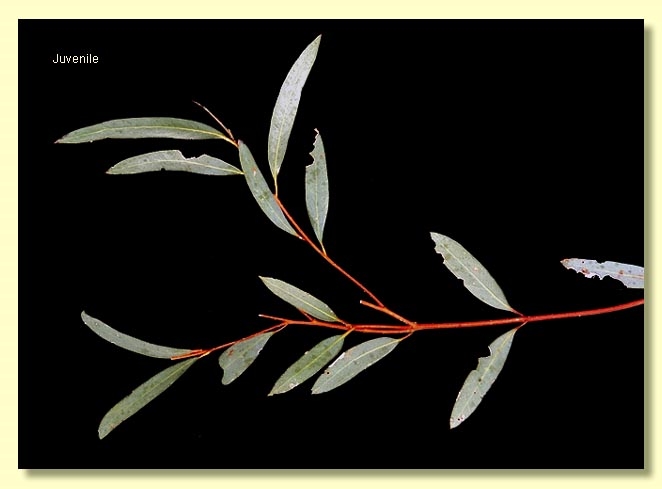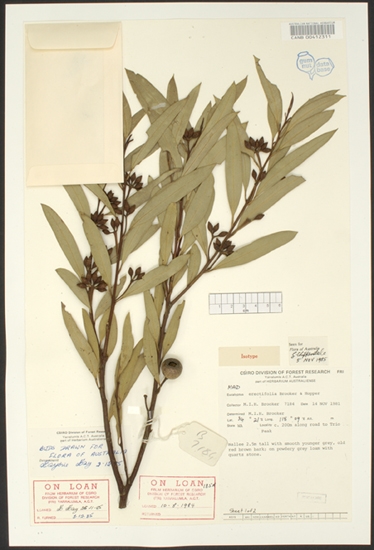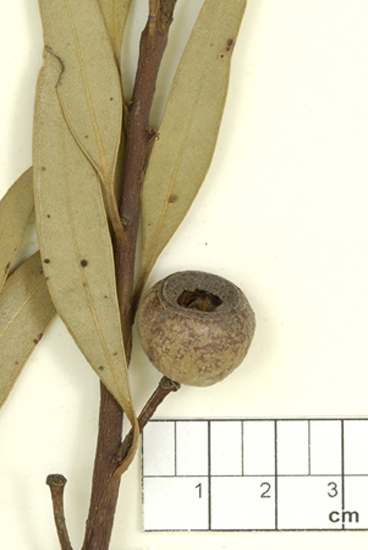Euclid - Online edition
Eucalyptus erectifolia
Eucalyptus | Eucalyptus | Longistylus | Frutices | Diversiformae | Neuropterae
Bark smooth grey-brown.
Branchlets lacking oil glands in the pith.
Juvenile growth (coppice or field seedlings to 50 cm): stems rounded to square in cross-section; juvenile leaves opposite, amplexicaul to petiolate, for lowest 2 or 3 nodes then alternate, petiolate, alternate, ovate to elliptical, 5–12 cm long, 1–2.5 cm wide, dull, light green.
Adult leaves erect, alternate, petioles 0.5–1 cm long; blade narrowly lanceolate, 5.5–10.5 cm long, 0.7–1.5 cm wide, base tapering to petiole, margin entire, apex pointed, concolorous, slightly glossy, green, side-veins acute, reticulation moderate, intramarginal vein close to margin, oil glands obscure or absent.
Inflorescence axillary unbranched, peduncles 1–2.5 cm long, buds 7 to ?13 per umbel, pedicels 0.1–0.4 cm long. Mature buds ovoid to broadly fusiform, 0.7–1.1 cm long, 0.4–0.6 cm wide, scar absent, the single operculum usually conical, stamens irregularly flexed, anthers ± cuboid, versatile, dorsifixed, dehiscing by longitudinal slits that curve apically but are not or scarcely confluent, style long and straight, stigma tapered, locules 3 or 4, the placentae each with 2 vertical rows of ovules. Flowers white.
Fruit sessile or pedicellate (pedicels 0–0.1 cm long), broadly cupular, 1.1–1.4 cm long, 1.4–1.8 cm wide, disc slightly descending, level or slightly ascending, valves 3 or 4, at rim level.
Seeds brown, 4–5 mm long, obliquely pyramidal, dorsal surface smooth, margin narrowly flanged, ventrally ridged, hilum terminal.
Cultivated seedlings (measured at ca node 10): (Information here is from the protologue and the one seedling we managed to raise to node 8 when it promptly died. Seed viability is low for this species.) Cotyledons reniform to orbicular, stem rounded in cross-section, warty to node 4; leaves sessile, amplexicaul to node 4 then base tapering, remaining opposite and held horizontally for 8 pairs, elliptical, sometimes apiculate, to 4–10 cm long, 2–6 cm wide, dull, blue-green.
Flowering has been recorded in March, April and May.
An small, erect mallee endemic to the Stirling Range area, in south-west Western Australia. The bark is smooth and the adult leaves glossy green and held erect.
Eucalyptus erectifolia belongs in Eucalyptus subgenus Eucalyptus series Diversiformae, a group of mallee species characterised by adult leaves held ± erect, buds with a single operculum (hence no operculum scar), cuboid-oblong anthers that shed pollen by two separate slits, ovules arranged in two rows on the placenta, pyramidal seed and seedling and juvenile leaves opposite for some pairs.
The flanged seeds, erect leaves and diamond-shaped buds indicate the affinity of E. erectifolia with E. buprestium and E. pachyloma. E. erectifolia has longer leaves and small broadly cupular fruits with a level disc compared with E. buprestium, which has spherical fruits with a descending disc. E. erectifolia is probably closest to E. pachyloma, which differs in the very short, stout peduncles, almost globose buds and very thick-rimmed fruits with ascending, not level, disc. All three species grow in the Stirling Ranges. Another similar, erect-leaved species is E. platydisca, from the Norseman area, but this lacks the flange on the seed.

